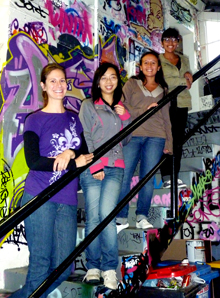Service Learning Down Under
While many Tulane service-learning courses contribute to the recovery and renewal of New Orleans, one course offered this summer has operated decidedly far afield. Eight students joined social psychologist Carrie Wyland in a class on inter-group relations in Sydney, Australia.

“Being an American in another culture as an outsider is an eye-opening experience,” says Carrie Wyland, left, a psychology professor of practice, who led students on a service-learning experience in Australia, including, from left, Joy Wan, Karen Bernstein and Sarah Javier. (Photo by Emily Brabeck)
Although their experiences took place half a world away from the Crescent City, the students encountered much that was familiar.
“Sydney is similar to New Orleans in that it is a city with a lot of wonderful cultural diversity yet, unfortunately, there is still some conflict surrounding that diversity, so there's an interesting parallel between the cities,” says Wyland, psychology professor of practice.
“I learned that lower economic status is a global problem, with the same issues as we have here,” says Sarah Javier, a psychology major from Pensacola, Fla., who completed her degree requirements for graduation in August. “All the similarities between our communities surprised me.”
Held in conjunction with the Tulane Center for Public Service, as well as the University of Western Sydney, the psychology course allowed students to complete 40 hours of service learning while working in the southwestern suburb of Liverpool.
There, the Tulane students worked with young Australians who have been denied access to mainstream post-secondary education. In this environment, students and community members at the Street University learned from each other, says Wyland.
“The focus of this program is on how groups interact, how people start to formulate identity within a group and within the larger community,” Wyland says. “I can teach all sorts of things about diversity, inter-group relations and other people in the classroom, but it's not until they're in that world that students understand it.”
